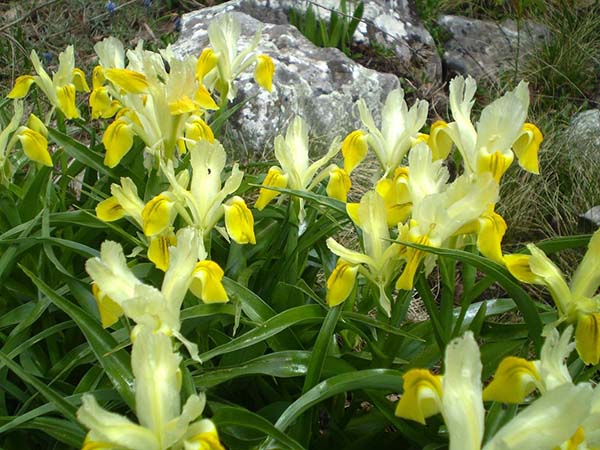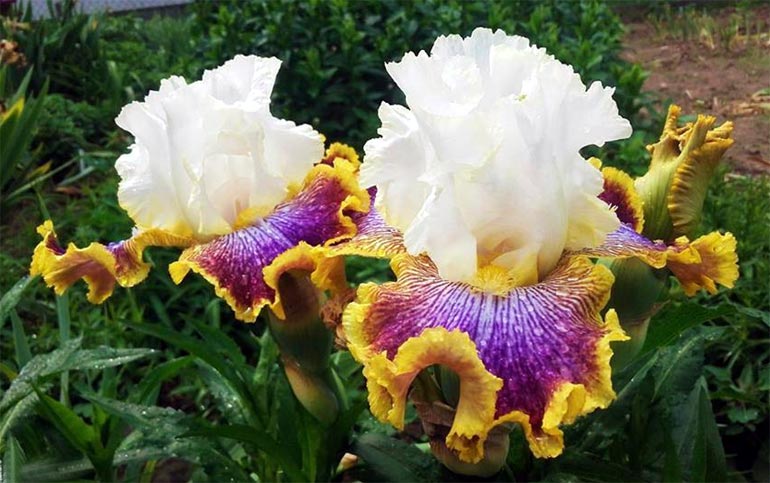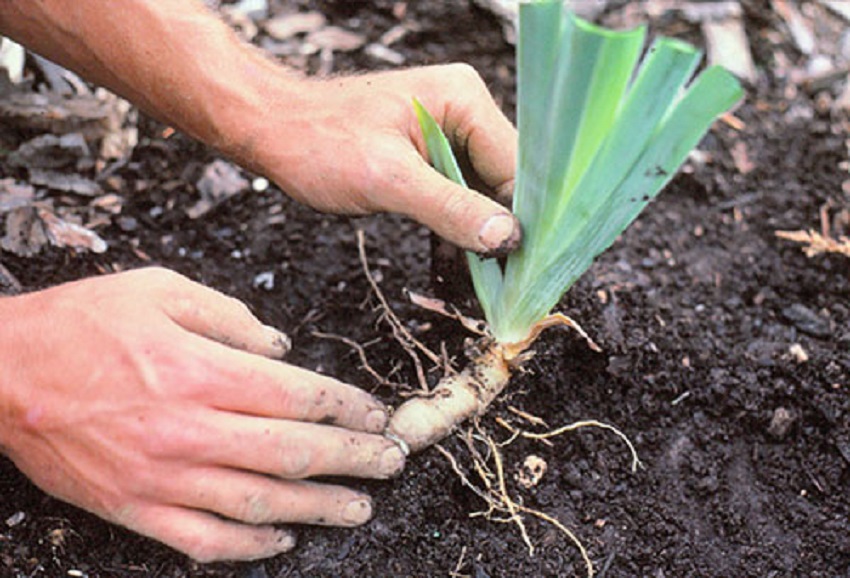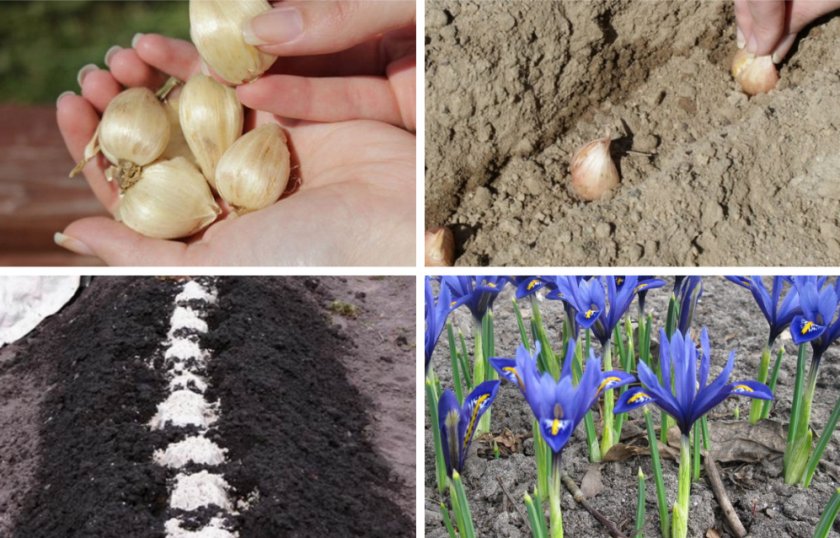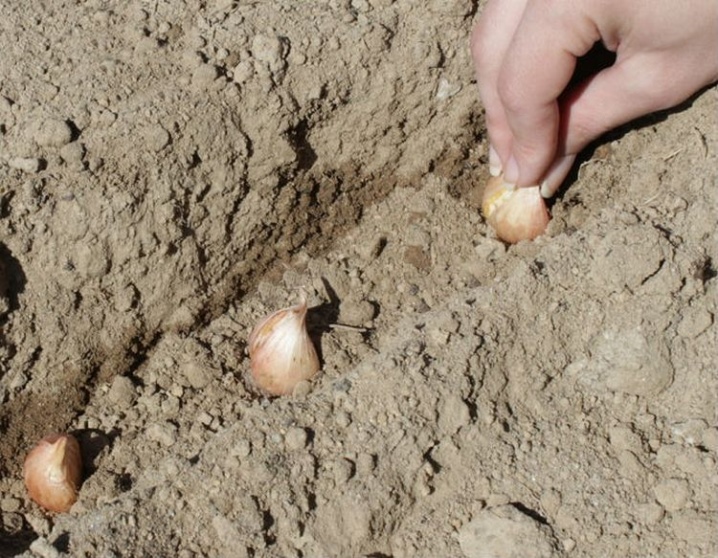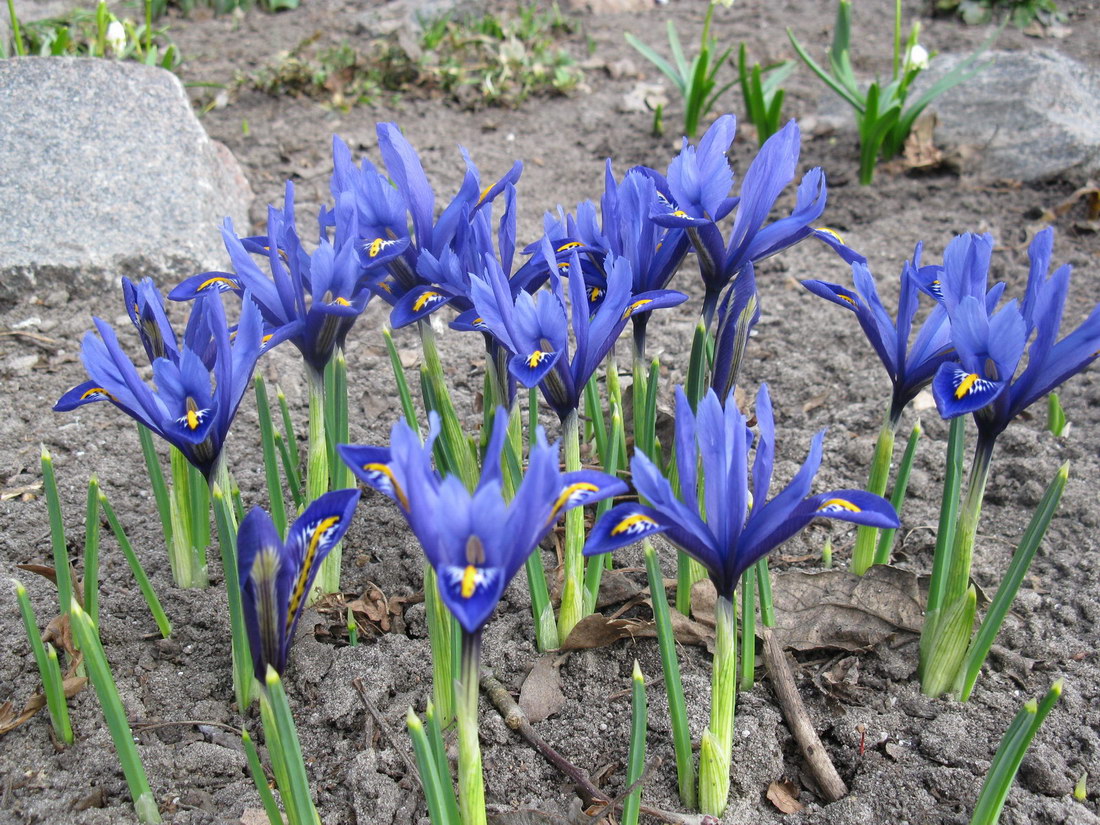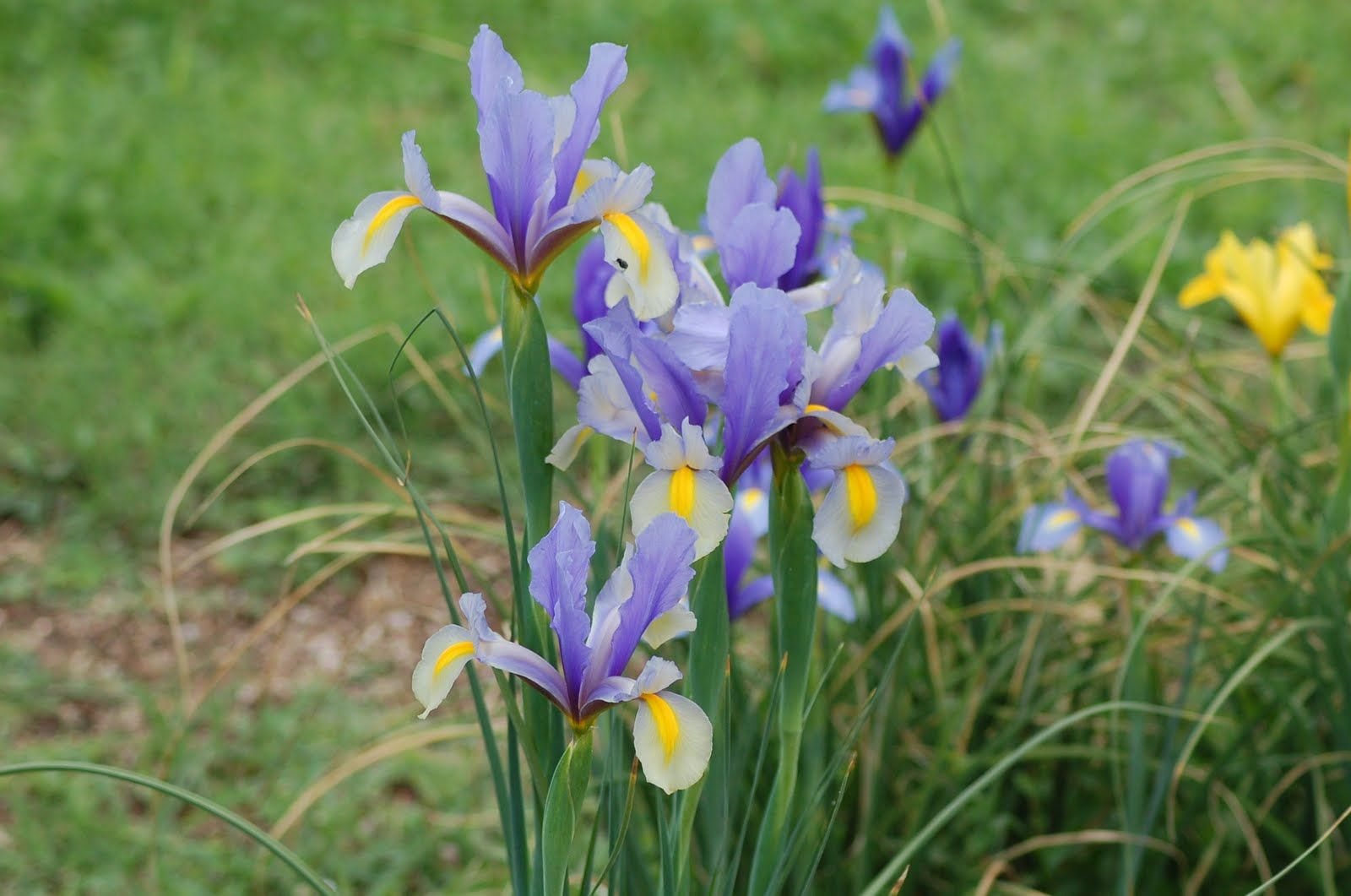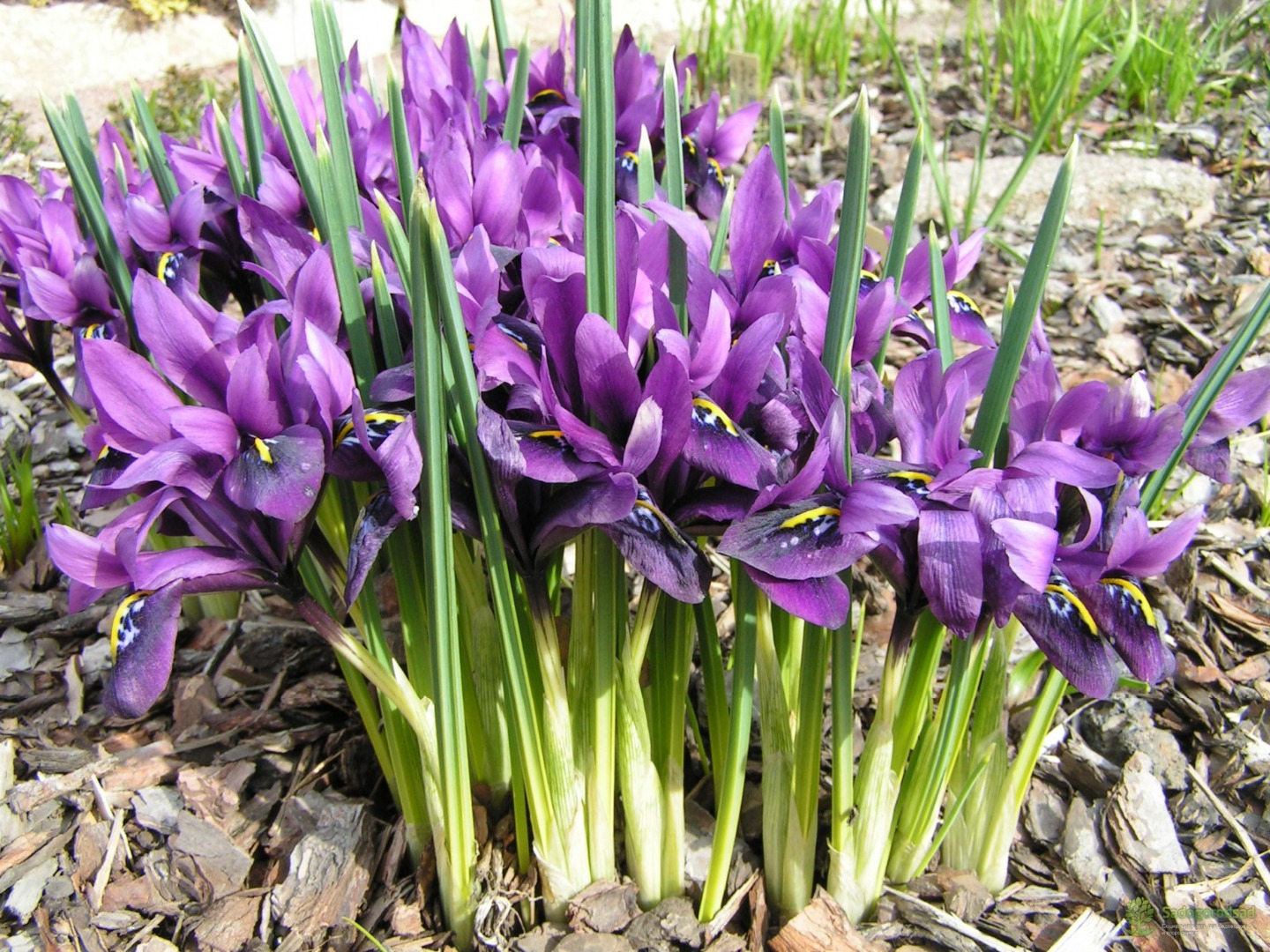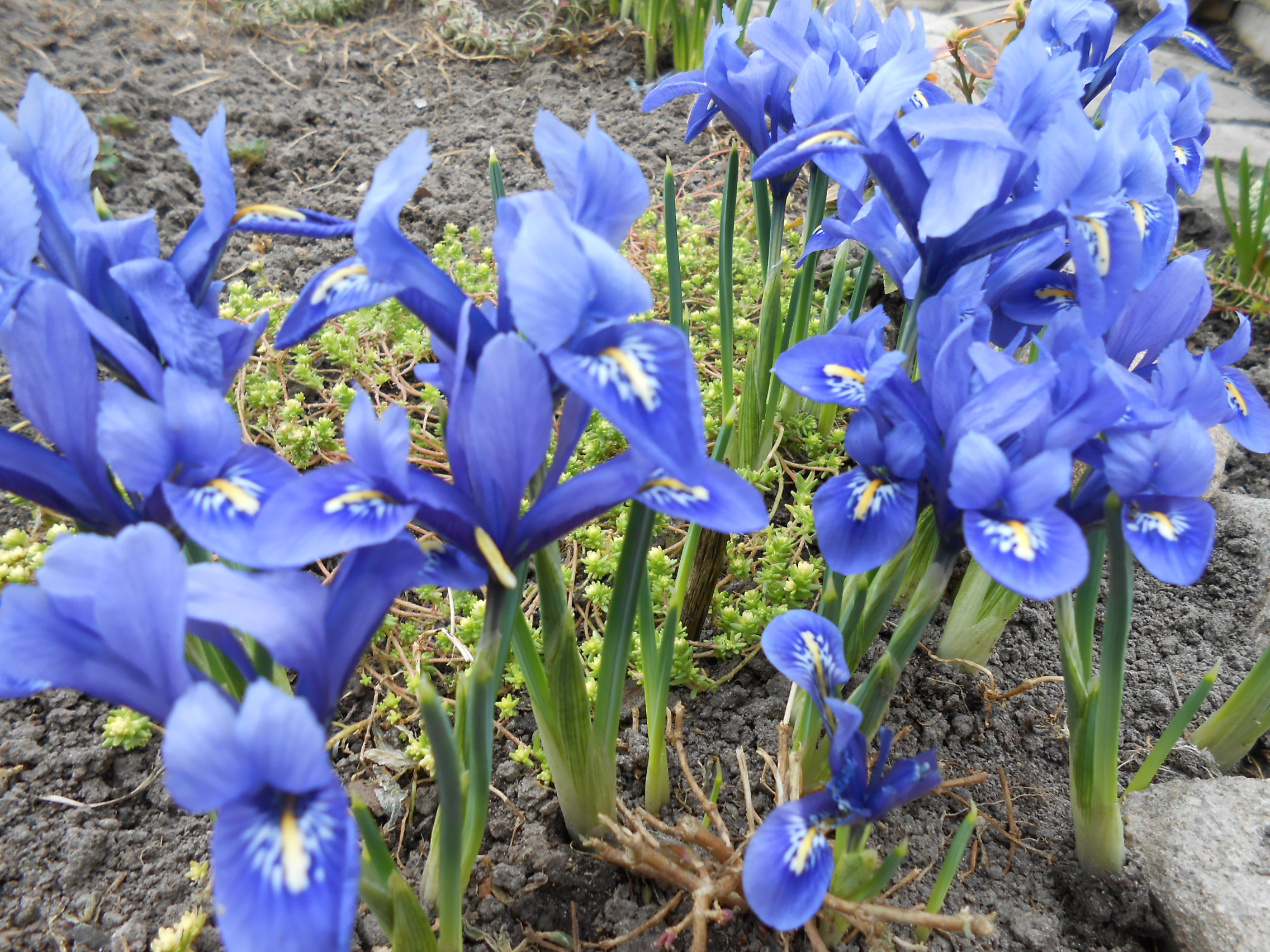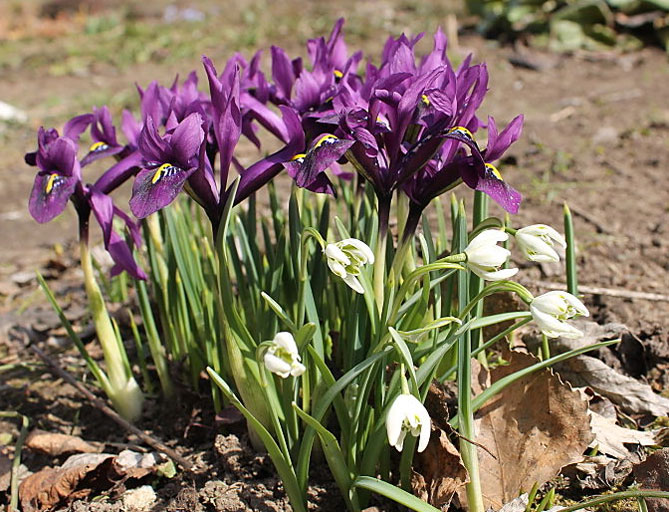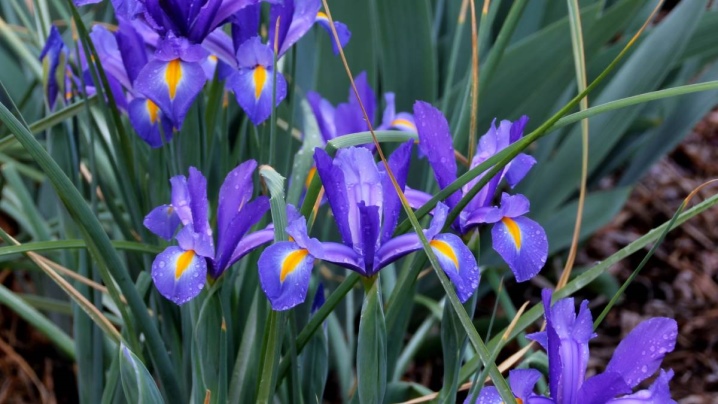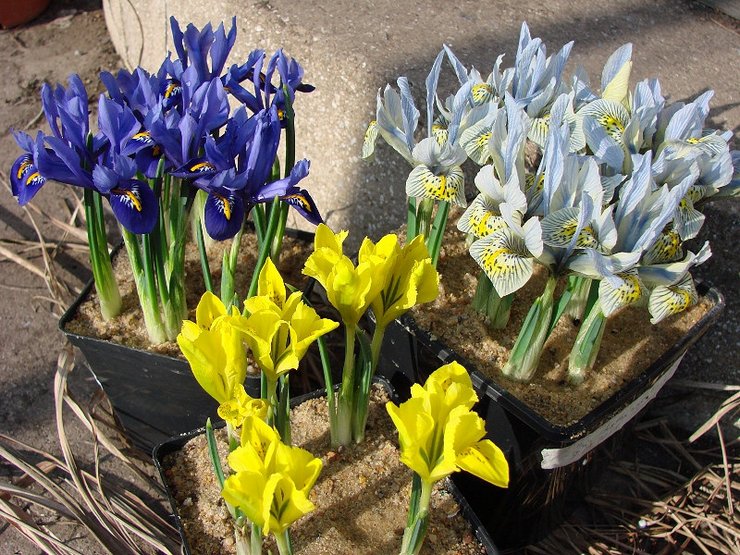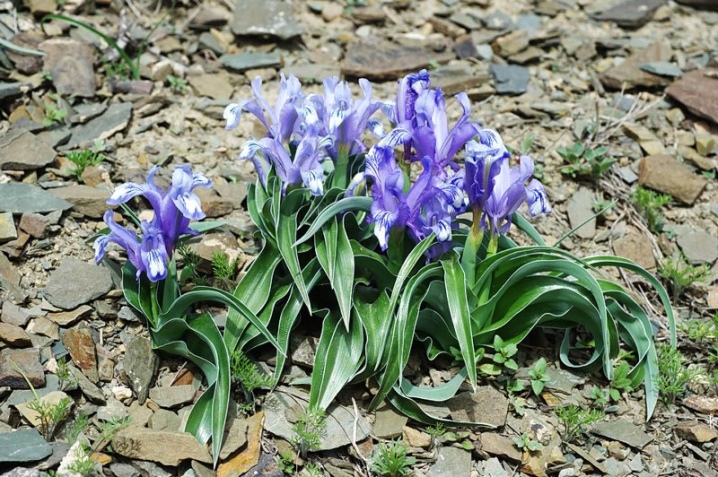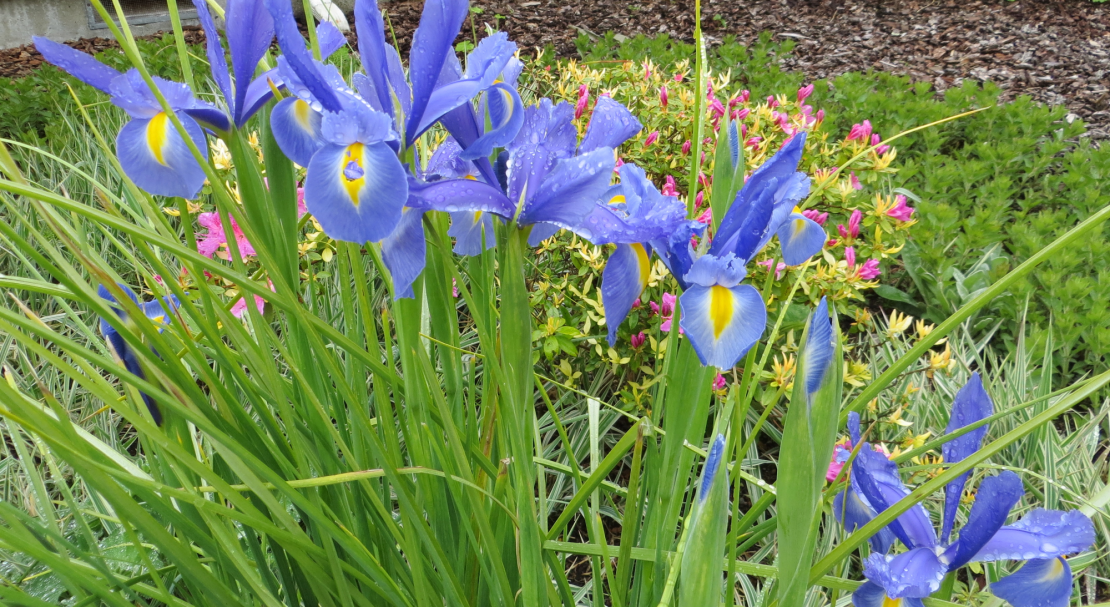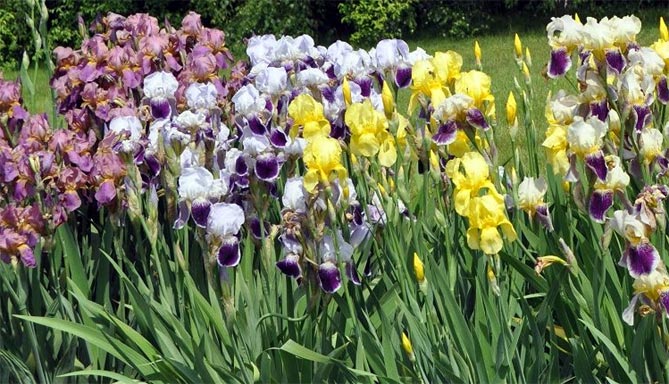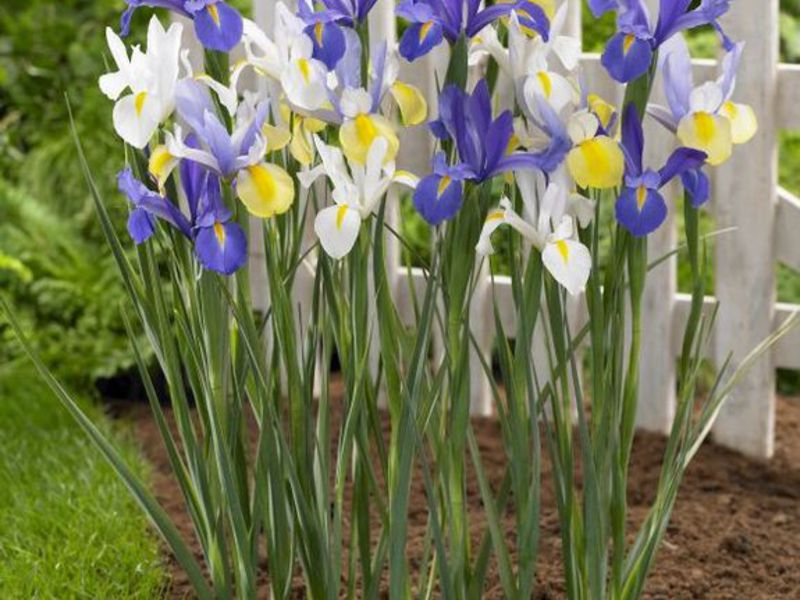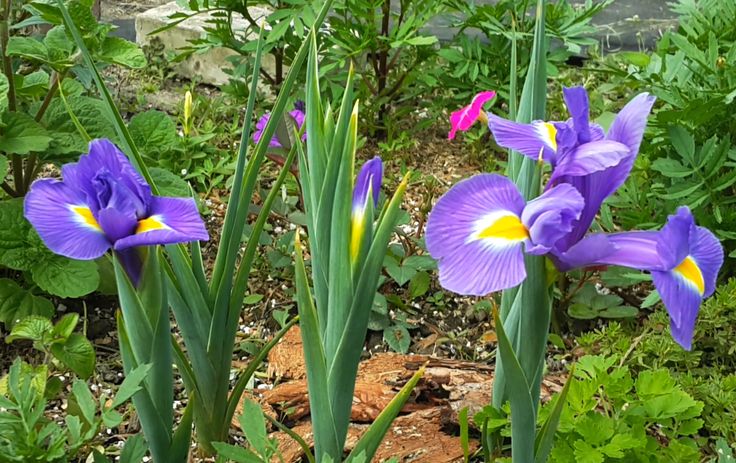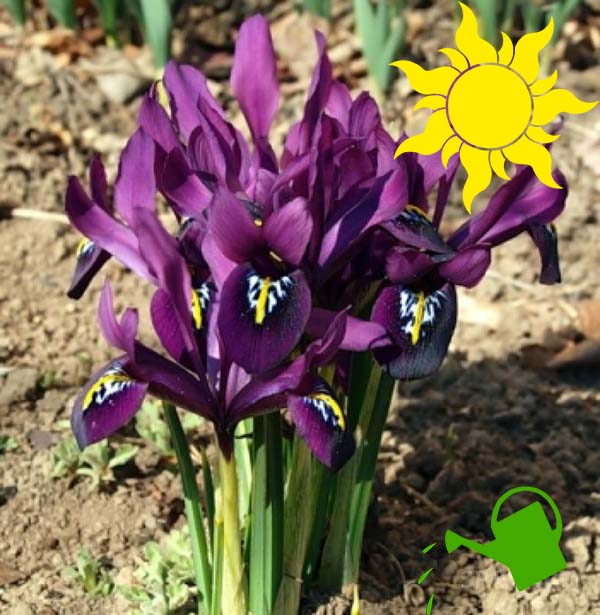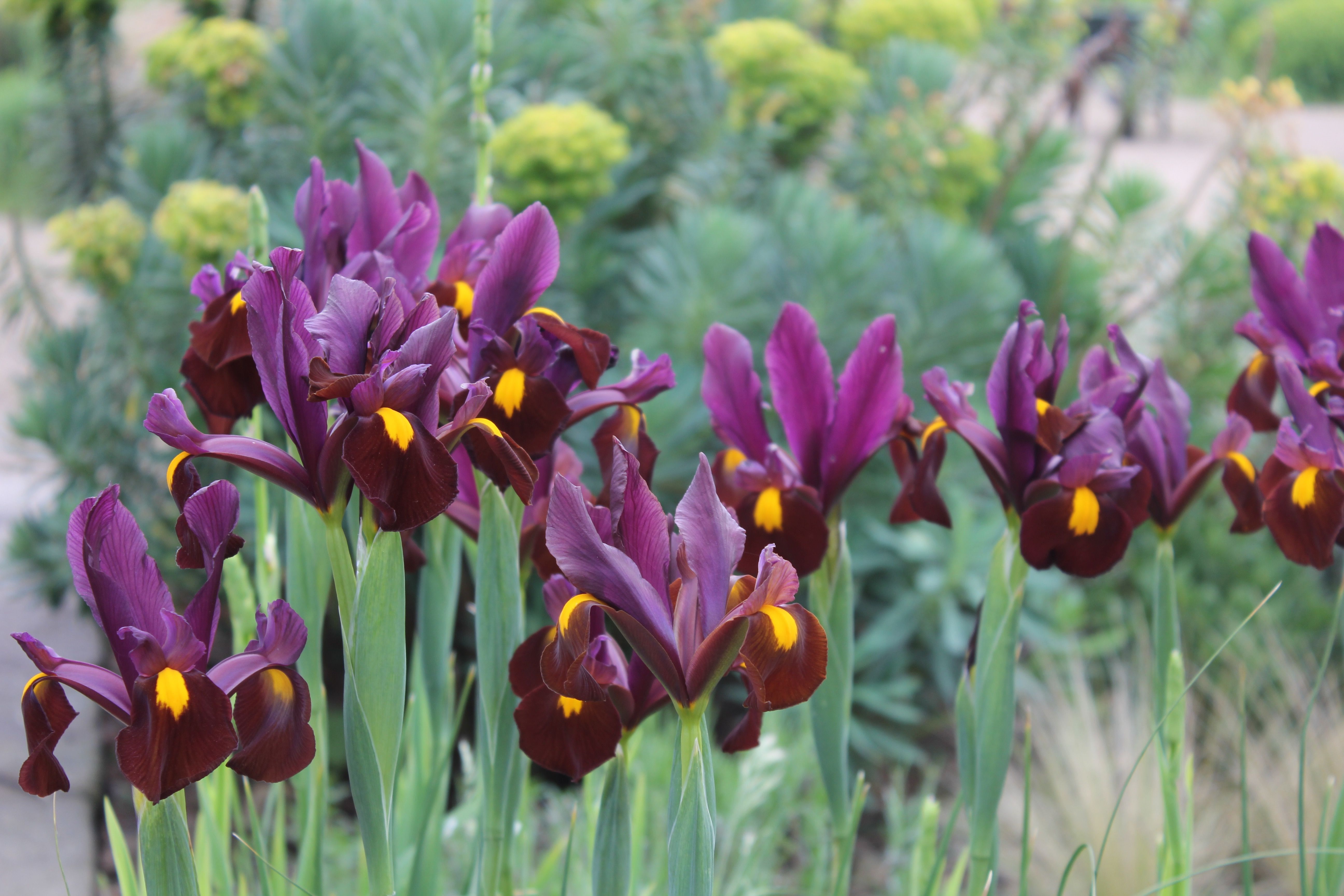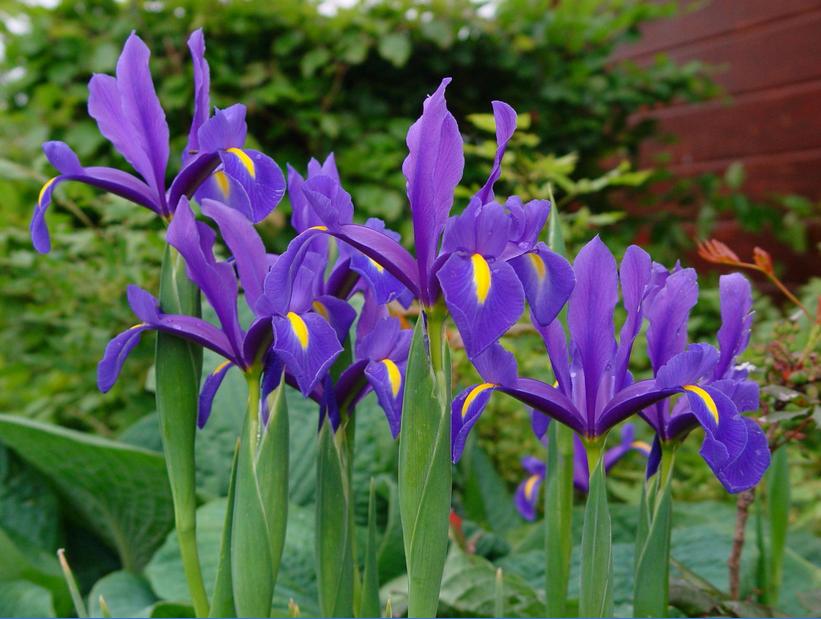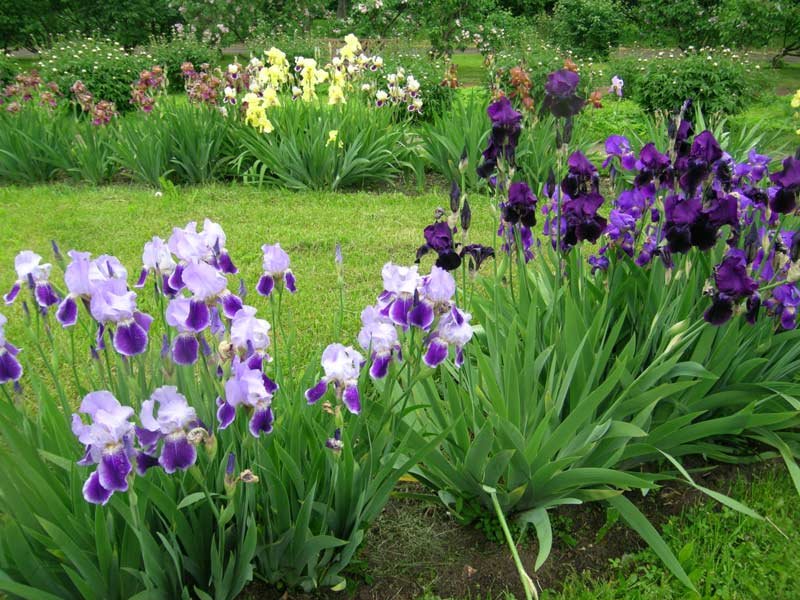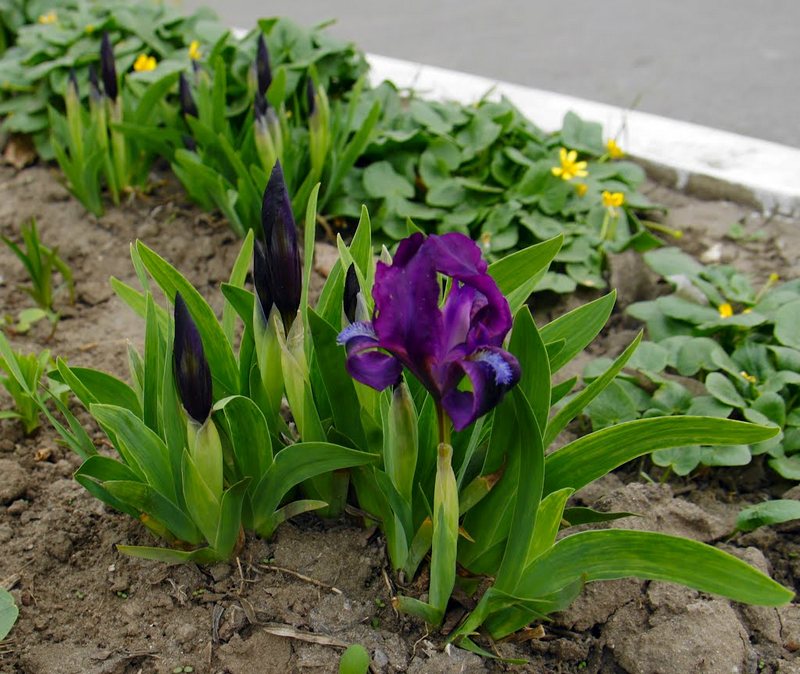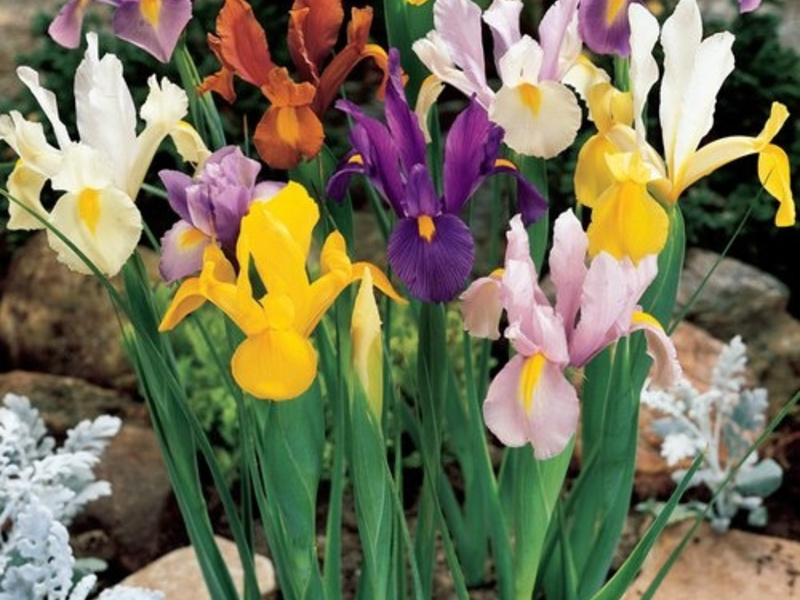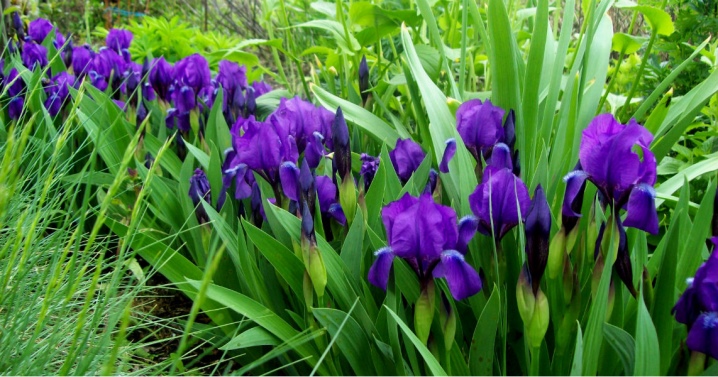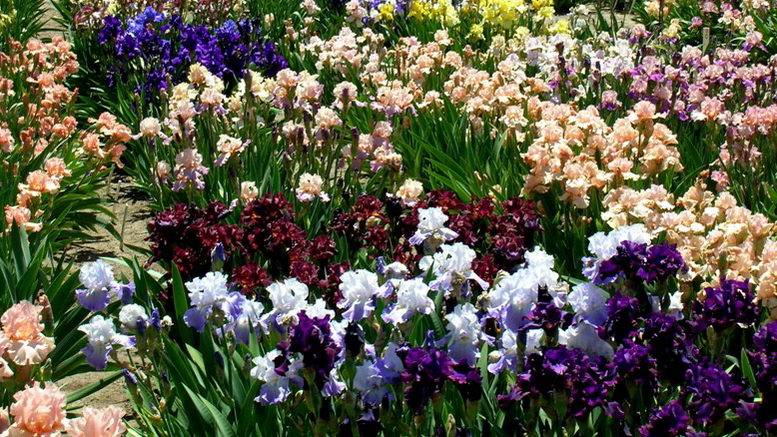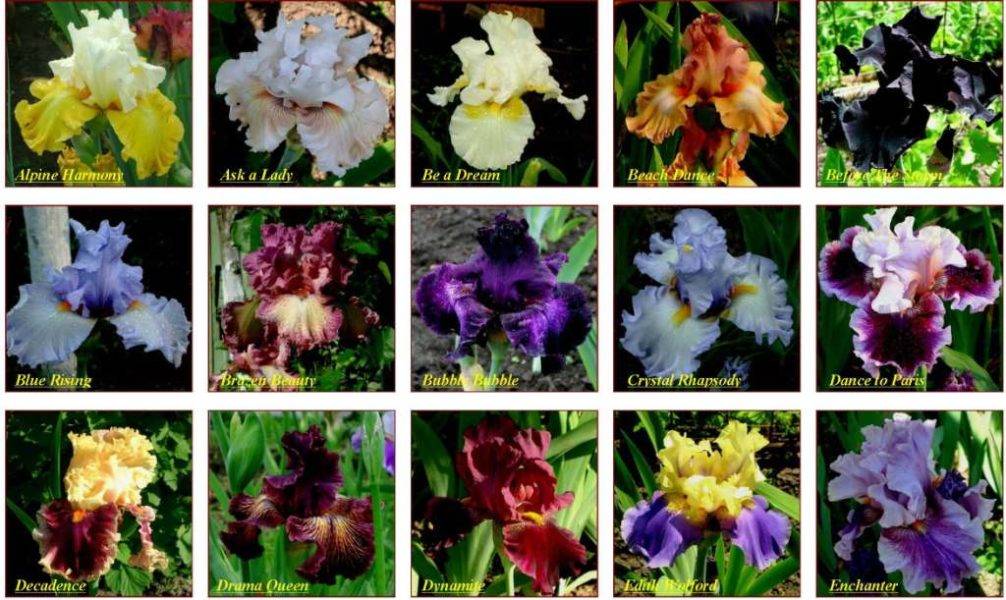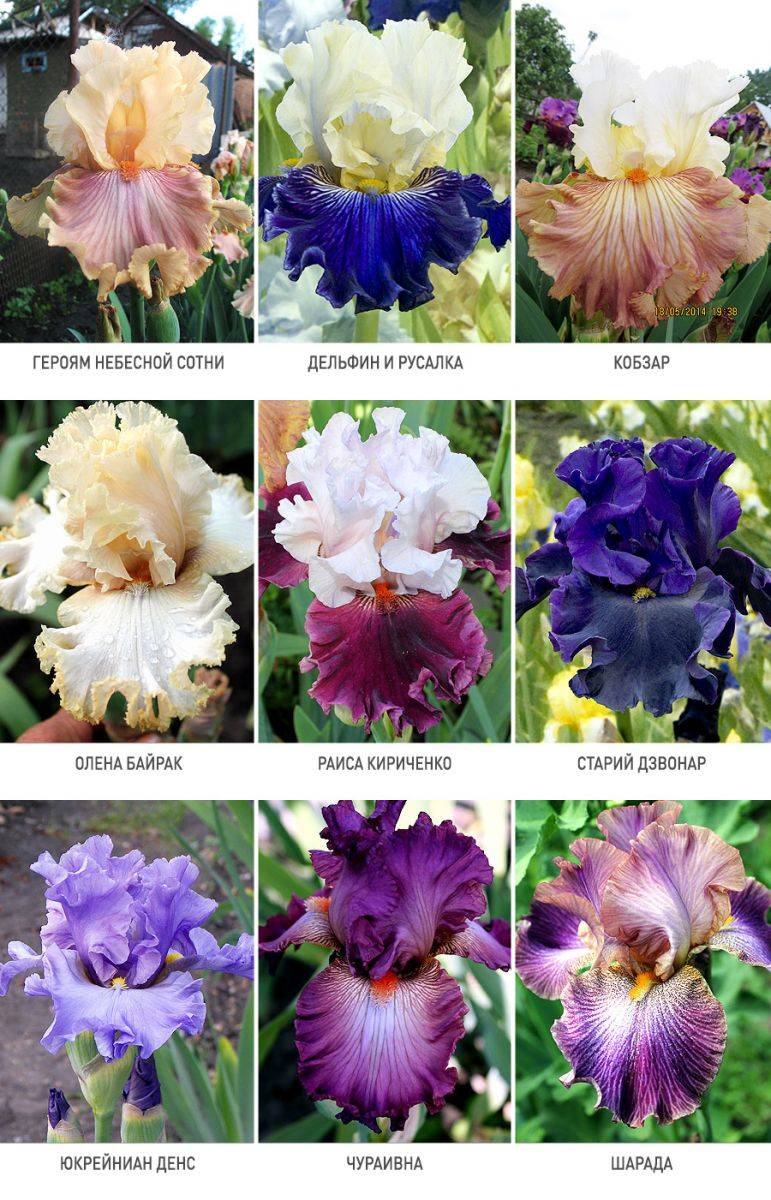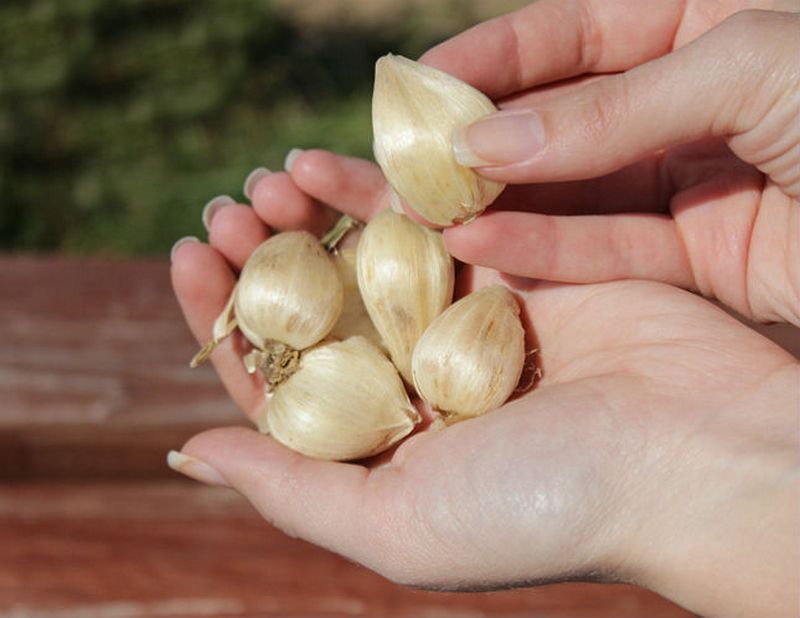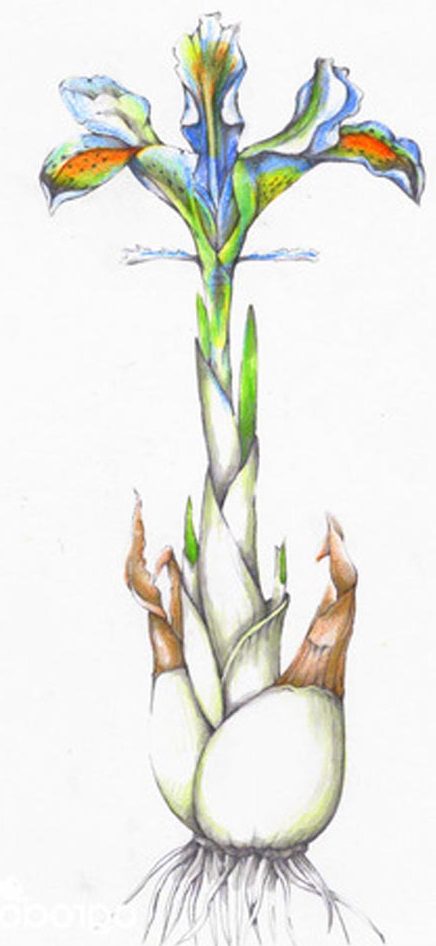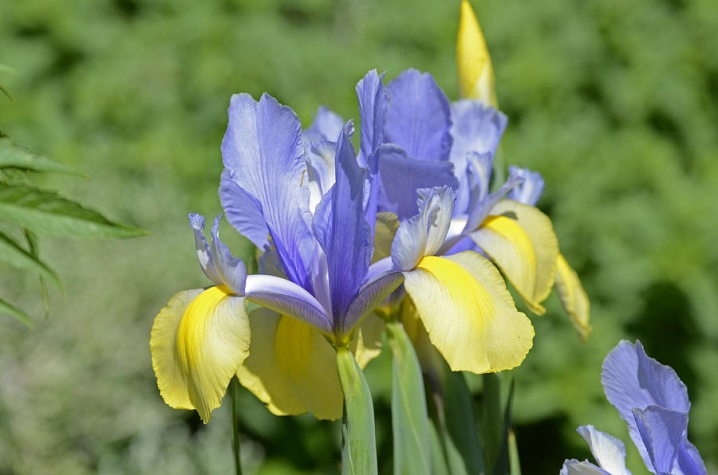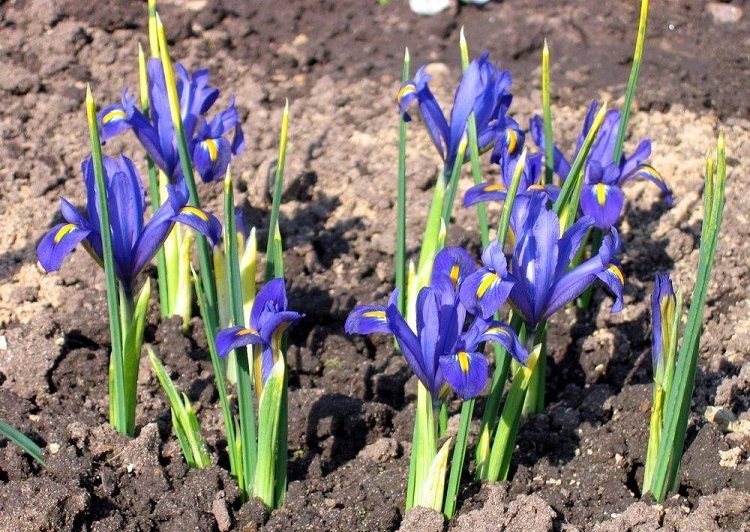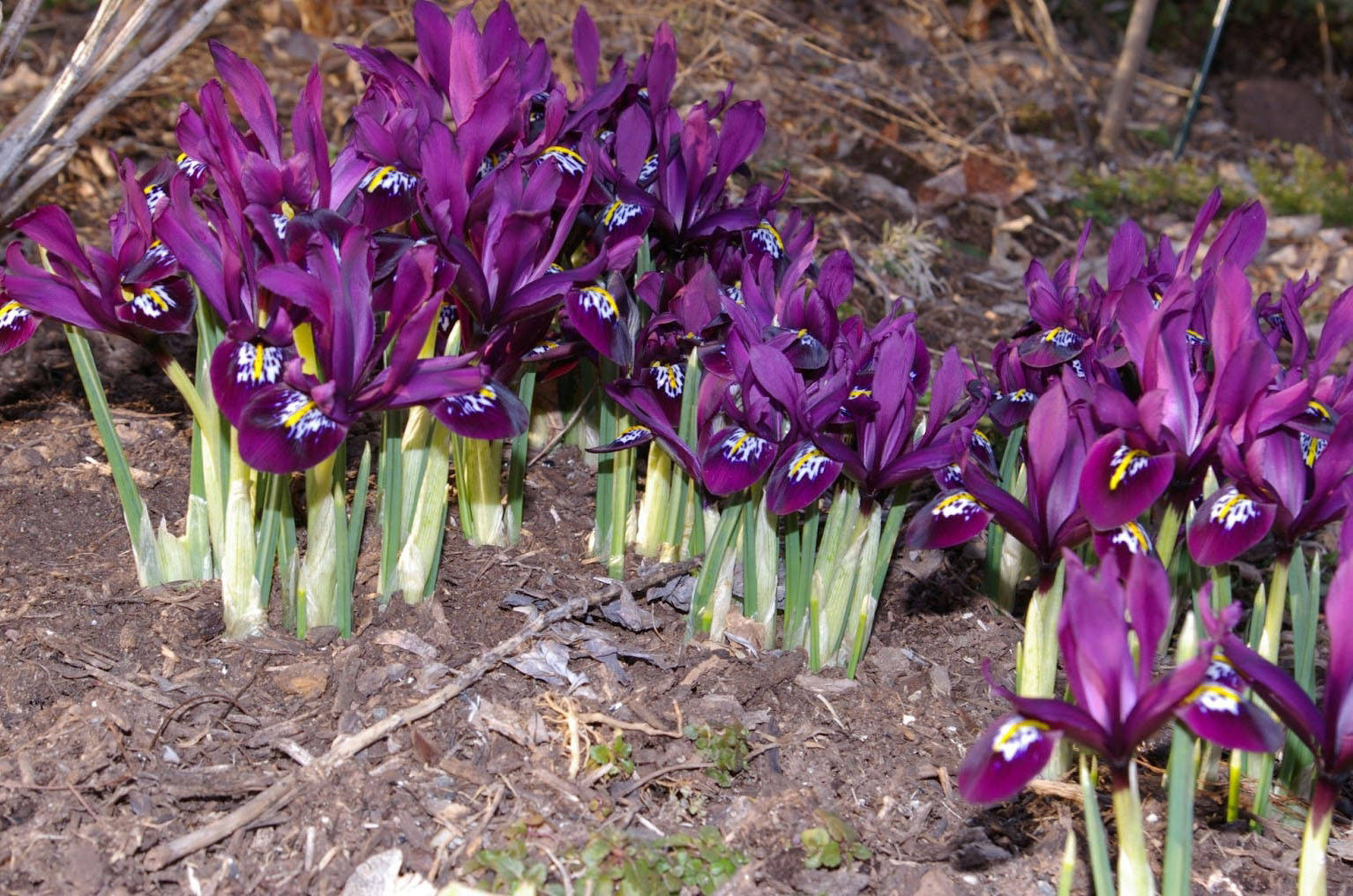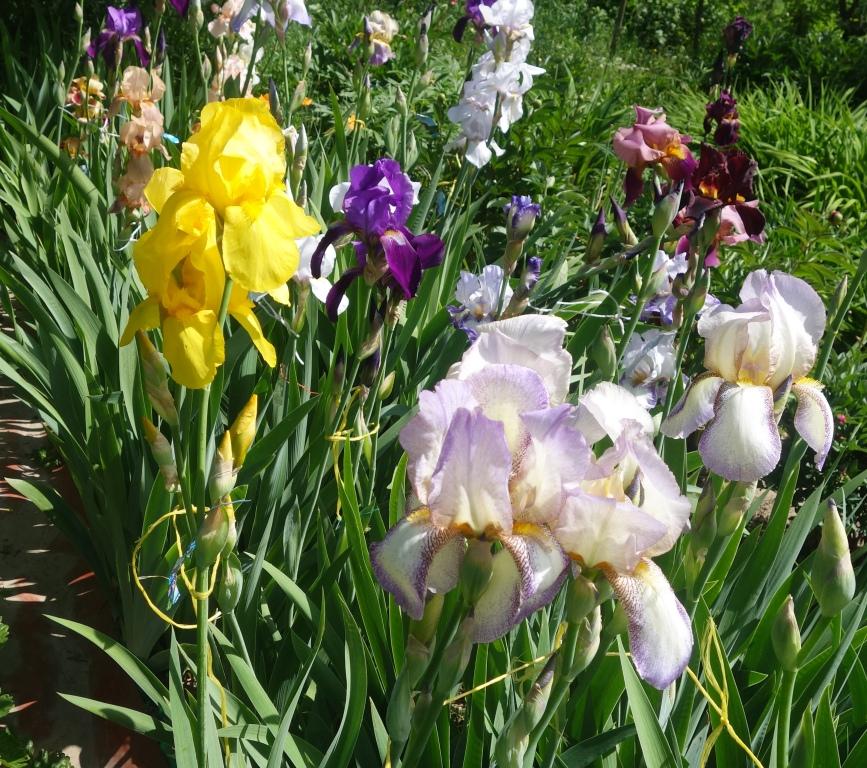Photos and names of iris varieties, conditions for growing and caring for flowers in the open field
Not all irises grow well in the gardens of central Russia. Most need a dry and hot summer, but our bulbs rot or shrink, the plants stop blooming and disappear after a few years. Therefore, planting irises on a site in open ground in this strip requires compliance with certain rules.
The most resistant yellow Iris Vinogradov (I. winogradowii) and its hybrids, for example, the widespread variety 'Katharine Hodgkin', reticulated iris (I. reticulatum) and its numerous varieties. Sometimes Mrs. Danford's sunny yellow iris (I. danfordiae) appears on sale. Unfortunately, he has not lived in the garden for more than three years. But look at the irises of this variety in the photo - they are really beautiful and worth taking care of:
Dutch, Spanish and English bulbous varieties - xyphyums - do not winter well, get wet. Planting these irises in open ground is not at all suitable for the gardens of Central Russia.
Intermediate (due to the presence of a bulb and developed fleshy roots) can be conventionally called another group of bulbous plants, which botanists have singled out as a separate genus. They are Juno. Look at the iris flowers of this variety in the photo, they are very delicate, but at the same time they are resistant:
They behave like ephemeroids, that is, they hide the aerial part at the end of July. Juno are very attractive, but we have them too damp and cold.
Juno of Bukhara (I. bucharica) is considered one of the relatively stable ones. These irises are flowers that have enough sunny space and drainage to grow, then they grow well and bloom stably. They winters excellently.
The variety of species and varieties of "traditional" rhizome irises (Iris) is great. In order not to get confused, you can use the table, which shows the garden classification of species and varieties of irises, in our climate, the growing conditions for which are most suitable.
|
Bearded irises |
Leafless iris (Iris aphylla), pale iris (Iris pallida), dwarf iris (Iris pumila), etc. |
They need good lighting, wind protection, drainage. The soils are light, neutral. medium and tall; dwarf; retro. Some varieties are very thermophilic and do not have time to flourish with us. |
|
Siberian irises |
Siberian iris (Iris sibirica), blood red iris (Iris sanguinea), golden iris (Iris chrysographes), Delavey's iris (Iris delavay), etc. |
The place is bright, but protected from the scorching sun. |
|
Irises spuria |
Iris pontic (Iris pontiisa), cereal iris (Iris graminea), false iris (Iris spuria), salt-loving iris (Iris halophila), etc. |
They are thermophilic, bloom for a long time; are more suitable for the southern regions. They love wet springs and rather dry summers, a sunny place. Soil - humus, clayey with lime |
|
Japanese irises |
Kampfer's iris (Iris kayetr-feri) = xiphoid iris (Iris ensata) and its varieties |
These irises often lack warmth in our country, they can freeze out. Therefore, the cultivation of these irises in the open field, especially new varieties, is possible without loss only after testing for resistance. For the middle lane, varieties of domestic selection are suitable. |
|
Louisiana |
Iris six-ribbed (Iris hexagona), brown-yellow iris |
May not be hardy enough. Plants for damp, well-lit, warm places. Humus soil, no lime |
Popular varieties
Bulbous specimens are divided into 3 independent genera: Iridodictium (reticulated), Juno (Juno) and Xiphion (Kasatik, or Cockerel).
Iridodictium (reticulated iris) grows well outdoors. Flowering occurs in the first 2 months of spring and lasts for 2 weeks.From different shades in the garden in spring, an amazing multi-colored carpet appears with and without stripes, with spots and just plain.
Did you know? Irises have been a flower icon for centuries, inspiring beautiful paintings, perfumes and even their own day, which falls on May 8th.
Iridodictium bulbs are small (1.5–2 cm), ovoid. The outer scales are fibrous, the inner ones are fleshy. The peduncle is poorly developed, at the end of flowering it is about 8 cm in size. The seeds are small, ripen in a triangular box, easily cracked. Suitable for cultivation are those bulbs that are at least 3-4 years old.
 The height of iridodictiums is up to 15 cm. The appearance of leaves occurs together with the buds. They are narrow and hard to the touch. Usually, this genus is characterized by the appearance of one exotic flower (diameter 5–7 cm).
The height of iridodictiums is up to 15 cm. The appearance of leaves occurs together with the buds. They are narrow and hard to the touch. Usually, this genus is characterized by the appearance of one exotic flower (diameter 5–7 cm).
Irises, plants that cannot tolerate excessive moisture. Fungal infection is a common enemy of plants growing in open ground. The rest of the Iridodictium is undemanding to care for.
Reticulated iris is the most common type. Flowers 5-6 cm in diameter. Aroma is not available in all varieties. The flowers are light red-purple.
Breeders breed the following varieties:
- Kantab is a frost-resistant variety with early and long flowering. It grows from 15 cm to 20 cm. The flowers are blue.
- Harmony and Joyce are decorative varieties that appear immediately after the snow melts. Peduncle up to 11 cm, has blue petals.
- Ya.S. Diyt (cockerels) is a winter-hardy variety, characterized by a single abundant flowering. The flowers are tiny, up to 8 cm, have a light purple tint or dark purple.
- Alida is a winter-hardy, unpretentious variety in care. Flowers of a blue hue. Flowering occurs from February to April.
- Royal (Dutch variety) - blue, yellow, dark cherry, violet-purple flowers with lilac edging are characteristic.
- Clairette (snowdrop iris) is a dwarf species, the country of origin is the Netherlands. Has two-colored perianths. The outer petals are cornflower-purple in color, the inner ones are pale blue.
- Katarin Hodkin is a very popular variety in Russia. Like gardeners due to its beautiful color. The upper flowers are lilac with a blue tint, and on the lower inflorescences there is a yellow speck on a purple-lilac background.
- Natasha - blooms in May-June. Differs in blue color of flowers with an unusual snow-white tint. The variety was developed by the Dutch scientist V.P. Van Eeden.
- Pauline - (Dutch variety). The plant is characterized by a juicy purple shade of flowers. Grows poorly in the shade, needs a lot of sunlight.
- George is a purple-flowered plant. The variety was also created by V.P. Van Eeden, named after the botanist Georgy Rodionenko, a specialist in plant acclimatization. Suitable for growing both outdoors and indoors.
The genus Juno is more numerous than the Iridodictium. It includes up to 40 species of bulbous plants growing in the Caucasus region, Asia, South African countries and the Mediterranean.
Varieties of Juno can have different heights: from 10 to 50 cm.The leaves are arranged on the stem in several rows. The appearance of flowers occurs from the axils of the foliage and in the apical part of the stem, therefore, often the appearance of up to 10 buds on one stem. Juno blooms in April-May. The flowers are white, yellow, purple and lilac. Popular varieties: Blue Mystery, Sindpers.
Xiphium is a group of 6 species. When planting a plant in open ground in the middle zone, an annual excavation will be required.
The varieties are often chosen:
- Symphony;
- Iris broadleaf;
- Frans Halls;
- Yellow Queen.
 Xifium leaves are narrow and elongated. The flowers are monochromatic, large (10 cm in diameter), look somewhat rustic when compared with other bulbous species. The height of the culture varies from 30 to 80 cm.
Xifium leaves are narrow and elongated. The flowers are monochromatic, large (10 cm in diameter), look somewhat rustic when compared with other bulbous species. The height of the culture varies from 30 to 80 cm.
Irises: planting and care in the open field
Irises are amazingly beautiful perennial bulbous flowers that amaze the imagination with a variety of shapes, colors and shades. This is probably why they got their name (from the Greek "iris") after the Greek goddess of the rainbow Iris.
The first mentions of iris in the annals of Ancient Egypt date back to the 15th century BC. The story is told about iris in the legends of Southeast Asia, Ancient Rome, Scandinavian countries and even Ancient Russia.
We have heard that it was the favorite flower of the Slavic god Perun, who called it "a symbol of spiritual purity, immense courage and desperate bravery." And then the iris was called in Russia "kasatik".
The people said that glades with blooming iris appear where Perun sent fire lightning. These places were considered reserved, curing any disease and fulfilling the most cherished desire.
But only a person with a bright and pure soul, who was also lovingly called Kasatik, could find the way there.
Iris flower meadows can be found in the central and southern regions of Russia, as well as in Siberia in the South Urals and the Far East.
The name of the flower in Russia remained until the beginning of the 20th century, and then another (scientific) one appeared - iris, when serious breeding work began all over the world to create new varieties and hybrids of this lovely flower that could decorate any flower bed.
In the 1920s, iris breeding was actively pursued in many European countries, as well as in the USA and Canada, Japan and Australia. These works were carried out in our country as well.
Since then, more than 40 thousand of the most diverse and spectacular varieties have been bred. If you choose them correctly, then the irises will bloom in your flower bed from late April to mid-August.
This flower is quite unpretentious and tolerates weather anomalies well. In addition, modern irises practically do not get sick. And planting in open ground and caring for them is not difficult.
Iris flowers are actively used in cooking. They make jam from them, make rich starchy flour for cakes, use them as capers in a marinade, add to soups and meat dishes as a seasoning.
Irises give off a wondrous, delicate aroma that fills the garden with an amazing magical scent. Therefore, plants are widely used in the perfumery industry for the manufacture of perfumes, creams, deodorants and very expensive powders.
In this article, we will tell you how to plant iris correctly, how to care for it and help you choose the best species and varieties for your site.
How to prepare bulbs for planting
Bulbs for planting irises are purchased at the store. You can also use your own planting material. It should be checked for quality. Do not plant damaged or rotten bulbs in the ground. It is necessary to soak the iris bulbs in advance in a growth stimulator. For disinfection of planting material, solutions of potassium permanganate or antifungal drugs are used. After processing, dry the bulbs for 30 minutes.
Site selection and preparation
Iris bulbous varieties should be planted in areas:
- well lit, or better a little shaded;
- with nutritious and loose soil;
- neutral in acidity;
- where groundwater is deep.
When the soil under the irises is sandy, humus can be added. In heavy soil - wood ash, sand. It is advised to neutralize the acidity of the soil with crushed eggshells, lime.
In what time frame do you need to plant
Experienced flower growers believe that the planting of irises will be more successful in the fall. Flowers take root best of all at a temperature of +15 degrees. For distillation, it is advised to plant in early February. Then by the spring they will receive delicate bouquets.
Landing scheme
Before planting the bulbs, they dig up the earth, loosen it. It is best to fertilize poor soils with nitrogenous complexes. The holes are made small. The burial depth of iris bulbs depends on the size of the planting material.Large ones are placed at a depth of 6-7 centimeters, small ones - 3-4. The upper part of the root system should be left above the ground, not buried. You can place the bulbs next to each other. If the plantings are single, then the distance between the flowers should be 10 centimeters.
Further care
Irises do not need special care during the flowering period. It is enough just to remove the wilting flowers.
Do this carefully, without damaging the leaves. Systematic loosening of the soil will provide the necessary access of air and water to the roots. Timely weeding will prevent weeds from overgrowing the plant
If there is a danger of a sharp drop in air temperature, you need to mulch the soil and cover. Young plants that are less than a year old need shelter for the winter. Adult plants tolerate winter frosts well.
For only planted bulbs, shelter can be:
- fallen leaves;
- pine or spruce branches.
 With the arrival of spring heat, after the snow melts, the shelter is removed.
With the arrival of spring heat, after the snow melts, the shelter is removed.
Watering and feeding
The next time after planting, irises need watering after 2-6 days. Weather conditions are an important factor here. When the buds begin to form, the soil is well moistened. During active growth and flowering, irises are watered as the soil dries up, but a crust should not be allowed to appear on the ground.
Important! Timely and balanced feeding will give an intense and productive flowering, add decorative effect to the plant. In the spring, in anticipation of the drying of the topsoil, fertilizers are applied
These can be ready-made preparations for bulbous flowers or dry mixtures. The soil is fertilized by scattering small granules on the surface of the ground, in the proportions indicated on the package.
In the spring, while waiting for the topsoil to dry out, fertilizers are applied. These can be ready-made preparations for bulbous flowers or dry mixtures. The soil is fertilized by scattering small granules on the surface of the ground, in the proportions indicated on the package.
There is a three-stage option for irises feeding:
- In spring, nitrogen (2 parts), phosphorus (1 part), potassium (3 parts) are introduced. This top dressing is added to dry soil.
- At the moment of bud initiation, the same composition is added, but in a different ratio - 3: 1: 3.
- A month after the beginning of flowering, plants need potassium and phosphorus in equal proportions.
Video: Top dressing for irises
Pruning
There are several stages of pruning. The first time, the dried flower stems are removed after flowering. This is done with special garden shears. It is necessary to retreat 2 cm from the bud and cut off the faded bud. Closed kidneys are not removed. After losing the decorative effect of the flower, the stem is cut at a distance of 2.5 cm from the ground.
During active growth, the stems are not cut, otherwise the plant will lose nutrients. It will also negatively affect the frost resistance of irises. Leaves that have turned yellow must be cut off. Withered inflorescences should not remain on the stems either. The leaves are removed in the fall (October), until the frost begins, the cut is made in the shape of a cone. A 15-centimeter stem is left from the ground.
Some varieties tend to bloom again. First in the spring and then in the fall. In this case, in July, after the end of flowering, the stems are cut off. This is necessary so that the energy expenditure is directed to the buds that have not yet blossomed.
Digging bulbs for the winter
Bulbs and tubers are dug up between the last days of summer and early autumn. Perform the following actions:
Raise the iris from the ground using a shovel or pitchfork. The bulb may have growing roots
You need to be very careful and try to keep as many roots as possible when digging them out of the ground.
If the lump of the iris begins to fall apart, then carefully break the large mass into smaller parts and carefully remove it from the hole.
Brush away as much soil as possible, breaking the lumps apart. This will help you see where the plant will split easily.
There may be large areas near the center of the bulb that do not have leaf fans.
They can be removed. It is necessary to check the bulbs for the accumulation of pests and the presence of diseases.
 The plant is discarded if any signs of infestation of the iris bulbs are found.
The plant is discarded if any signs of infestation of the iris bulbs are found.
Reproduction
You can propagate the culture vegetatively (by dividing the rhizomes), This is the easiest method to get beautiful and large iris bushes. You can also try to seed the flower.
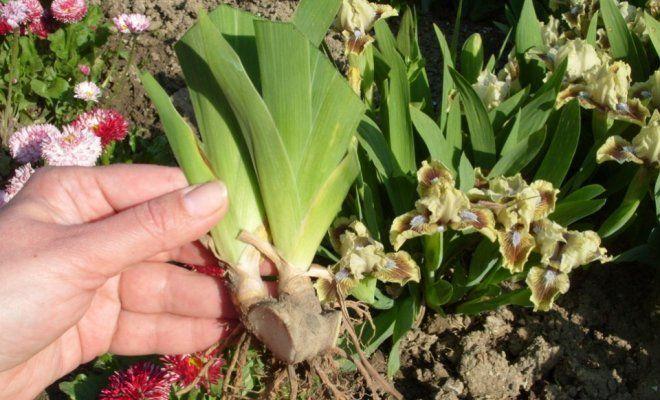
Breeding with roots
Iris has been growing in one place for 10 years, but in the return of 4-5 years it is recommended to dig it up, then divide it and plant it. The right time for this procedure is immediately after flowering for 1 month. Dig out the rhizomes, cut the foliage at a height of 10-15 cm from the base and divide into pieces 3-4 cm long.Each division should have 2-3 buds and 2-3 links
It is important to process the sections using crushed coal. Plant the plants in holes or grooves, deepening by 3-4 cm, 24 hours after performing the division procedure, since the sections must dry out in order to avoid decay in the soil
Advice! If tall varieties of iris, then adhere to the distance between planting units and rows of 50 x 50 cm, medium-sized - 30 x 30 cm, dwarf irises - 10 x 15 cm.
Seeds
Only perennial crops can be grown in this way, since seedlings do not retain the varietal qualities of their parents. To do this, in the fall, after harvesting the seeds, they need to be sown on a bed in a loose soil well fertilized with nutrients to a depth of 1.5-2 cm. Seedlings will not take long to appear and will appear in the spring. Place them at a distance of 5-10 cm from each other. Plant on a permanent flower bed in 2 years, and they will please with flowering for the 3-4th year.
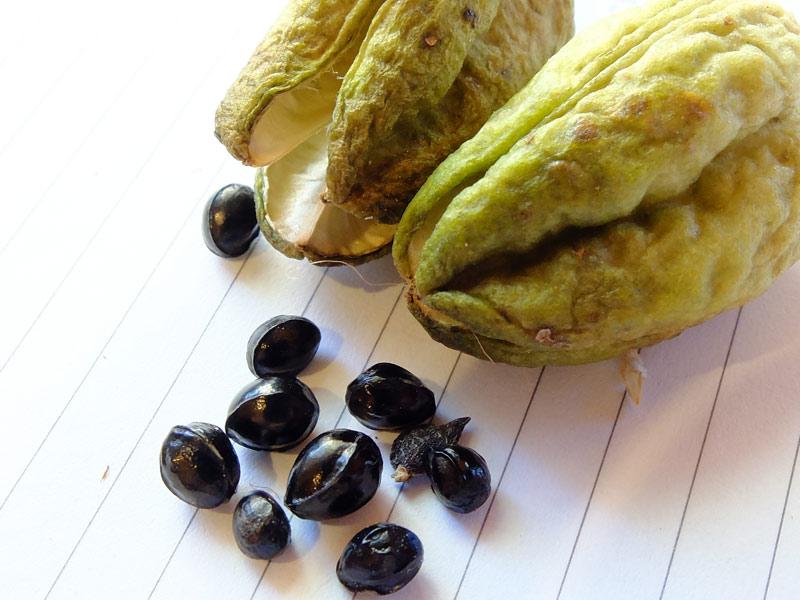
If planting works are planned in spring, then stratify iris seeds in advance for 1.5-2 months. To do this, send them in a bag of sand and put them in the cold.
Planting rhizome irises
The planting material is a fan of leaves with a rhizome, from which the roots extend. Such material can be purchased ready-made in gardening stores or prepared independently by dividing the rhizomes of growing flowers into parts.

Before planting, the root is recommended to be kept in a potassium permanganate solution for about half an hour. We make a shallow hole in the ground, then a small mound in the hole, on which we lay the root and sprinkle it with earth along with the roots.

Leave the back of the rhizome open. American botanists advise planting the back to the east so that it is illuminated by the first rays of the rising sun. After that, it is necessary to water at the rate of one liter of water for each well. It is advisable to leave the distance between the holes on average 30-50 centimeters.


Be sure to mix the soil for planting with sand and ash. Disembarkation is best done in a dry, sunny place. When using planting material with a fan of 7-8 leaves, irises can bloom in the very first spring after planting. In other cases, after 2-3 years.

Description of the Dutch variety
Dutch iris is one of the varieties of irises. This is xyphyum. In flower shops, you can buy flowers in the form of bulbs, which are covered with multiple layers of scales. On average, the plants reach a height of 0.6 m. Some varieties, for example, Casablanca, Blue Diamant, grow within 0.5 m. They do not require support if they were planted in a wind-free place.
The plant tolerates frost well, but requires shelter at very low temperatures to prevent freezing. Bulbous irises bloom in the last week of May and bloom until early June. Iris flowers can be of the most varied colors: white, blue, purple, orange. After flowering, the foliage begins to dry, and at the end of August it dries up completely. Dutch irises are widely used in gardening, they are used to decorate flower beds, flower beds, they are used to create beautiful flower arrangements and bouquets. For many, irises are the best flowers, harbingers of warmth, because they bloom very early.
Features of breeding xyphyum
To obtain beautiful flowers and healthy bulbs after planting xyphyum, careful care is required, especially since the growing season for this plant is very short.
Location. Choosing the right place is very important when breeding, since the decorativeness of the flower will largely depend on this. Preference should be given to well-lit areas protected from gusty winds and drafts. This crop should not be planted in places where it will be in direct sunlight for a long time, this can lead to leaf burns and rapid withering of inflorescences. You can plant a tall Dutch iris in a secluded corner of your garden near a pond or recreation area. You can not plant xyphyum in places with a close occurrence of groundwater. When grown in lowlands, a drainage layer should be laid in the pit before planting.
The soil. The plant prefers loamy or sandy loam soils, well-drained, neutral or slightly alkaline. If there is clay soil on the site, you will need to add peat, humus and sand at the rate of 5 kg per 1 square meter. If necessary, the indicated dosage can be doubled. Sandy soil is also not suitable for a plant, as well as clay soil, since in this case the root system will dry out quickly, and all valuable substances will not be able to stay at the roots. Peat, organic fertilizer and clay are added to the sandy soil.
Fertilizer. You only need to feed a rooted plant that has at least one pair of leaves. A nitrogen-containing fertilizer, such as urea, is ideal as a first top dressing. The second top dressing is applied during the budding period, using a mineral complex with an increased content of nitrogen, phosphorus, potassium. The third feeding is required after the flowering of the bush. In this case, a mineral fertilizer with potassium and phosphorus is suitable. The place for growing xyphyums must be fertilized periodically: once every 5 - 6 years, organic fertilizers are applied to the soil.
Watering and other care. Frequent watering when growing xyphyum is not required, it is enough to irrigate the bushes during dry periods. Watering is carried out until the foliage is completely dry. After watering, it is necessary to loosen the soil, remove weeds. The flowers are cut half-open or at the stage of a colored bud, while leaving two lower leaves on the stem.
Preparation for wintering. The plant is not resistant. In the middle lane for the winter, the bushes are cut off, leaving hemp 5-10 cm long, then covered with dry leaves, peat at least 25 cm thick, and a layer of spruce branches. In winter, a thick layer of snow is applied to the garden bed. The harvesting of the bulbs begins when the leaves turn yellow. The bulbs are dried, peeled and stored until autumn.
How to care for bulbous irises outdoors
In principle, there is nothing difficult in the care and cultivation of bulbous irises, but some standard garden manipulations still have to be remembered and carried out.
Watering
Bulbous irises require moderate watering
It is especially important not to forget to water the plant in dry weather (including in the fall after planting, if there is no rain at all), namely during the period of their active growth, that is, during the formation of buds and direct flowering. At the end of flowering, watering is no longer required
Flowers now need dry dormancy.
Top dressing
If you want a brighter and more lush bloom, then you should fertilize the irises several times in the spring.
- So, during the first feeding, which should be performed immediately after removing the shelter, that is, even in the very early spring, at the beginning of the growing season, nitrogen fertilization must be applied (a small content of potassium and phosphorus is also allowed).
- When the budding period begins, the flower should be fed with potassium-phosphorus fertilizer (with a high potassium content, nitrogen is also allowed).
- Immediately after flowering, only phosphorus-potassium dressing should be performed.
Digging the bulbs
It is very important to dig up the iris bulbs in time, otherwise they can rot due to excessive moisture (rain). If tulips, as a rule, are dug up only after their leaves turn yellow, then in the case of bulbous irises there is no need to wait so long.
It is optimal to get them out of the ground about 2 weeks after flowering, when they just wilt slightly and begin to turn yellow. As a rule, this moment falls on the end of May - beginning of June.
The dug iris bulbs should be disinfected in a pink solution of potassium permanganate or any other fungicide (for example, "Maxim Dachnik" or "Fundazol"), then dry thoroughly (2-3 weeks) and put into storage in a dry room with good ventilation until a new autumn planting into open ground.
Shelter for the winter
If autumn is rainy, then so that the iris bulbs do not get wet from excessive moisture, they should be covered with something, for example, roofing felt or a plastic cake box.
If your winters are cold and snowless, spruce branches and dry leaves are suitable for a winter shelter, you can also cover it with spunbond or film. Especially the more thermophilic junons need shelter for the winter.
Thus, the main care for bulbous irises in the spring consists in removing the shelter, watering them (and then loosening them), feeding and digging at the end of flowering.
To get more positive from a delightful flower, you need to seriously think about the intricacies of planting and growing bulbous irises in the open field.
Video: features of planting and growing bulbous irises
How to plant bulbous irises in open ground: rules and recommendations
To successfully grow your favorite flowers, you must consistently and clearly follow the following rules and recommendations.
Planting site and soil
It is optimal for bulbous irises to choose a well-lit, sunny and calm place, without access to drafts, in light partial shade. Like all bulbous plants, lowlands (in which moisture will accumulate in the spring) and areas with too close groundwater are categorically unsuitable for planting. Excessive moisture is detrimental to the bulbs.
For planting spring bulbous irises, choose places near your home or near garden paths so that they often come across your eyes during their short flowering. A rock garden or rocky garden is perfect. It is beautiful to plant them next to other bulbs blooming in early spring, for example, with the same crocuses, daffodils, tulips.
With crocuses
As for the soil, it is good to plant these bulbous dogs in light, permeable and fertile soil with neutral acidity.
Preparing the bulbs
If you do not want your iris bulbs, God forbid, to rot, then before planting, hold them in a solution of potassium permanganate or a special fungicide for etching, such as "Maxim Dachnik" or "Fundazol".
Direct landing
Step-by-step instructions for planting bulbous irises in open ground:
- Decide on the best place for growing.
- Prepare planting holes and soil. Make drainage (pour a small layer of sand), if necessary (for loose soil, it is not needed).
- The planting depth of iris bulbs is 3 bulb heights, that is, about 5-8 cm.
- The distance between the bulbs of irises is 2-3 bulb diameters (6-10 cm). But if you want to get a beautiful bouquet, then plant it closer.
- Place the bulbs on the bottom of the hole and press them lightly into the ground (or sand).
- Cover with fertile soil.
- Drizzle slightly with water.
- Cover with compost or peat.
Treatment of diseases and methods of pest control of irises (with photo)
Many people think that irises are not susceptible to diseases and pests, since some plants can often be found in city flower beds or simply in the wild. There is rationality in this judgment, since this flower is really considered quite persistent.
But, like any other plant, irises can get sick or be attacked by pests.
The weak point of irises is all kinds of fungal diseases, there can be a whole "compote" of them: rust, fusarium, gray rot, bacterial rot. The main thing is to plant irises in suitable places and follow the rules of care. Always have fungicides in your garden medicine cabinet to apply them as early as possible.
Despite the fact that the reproduction of irises is largely carried out in a vegetative way, then such diseases of irises - look at the photo - as bacterial or soft rot (or bacteriosis) of rhizomes, occurs most often:
It has been proven that this disease is caused by the presence of a certain group of bacteria that settle in the underground part of the plant and feed on nutrients that accumulate in the tubers. The following factors can contribute to the uncontrolled development of this microflora:
- excessively moist soil;
- organic fertilizers applied in large quantities to the soil;
- too thick planting of the plant.
Decay of the root system, its softening, a tilted fan of plant leaves - all this is a manifestation of iris disease. And the correct fight against them should be carried out as quickly as possible so that the flower does not die.
Even an already heavily affected plant can be saved from bacteriosis. Look at the stages of iris disease and the fight against it in the photos below:
- A ball of soil is removed around the affected bush to free the rhizome as much as possible.
- The affected and soft areas in the underground part of the plant are removed or scraped off to living tissue.
- Treatment is carried out with parchment potassium, bleach or hydrogen peroxide, which has proven itself on the positive side in recent years of use in horticulture.
- The affected, but treated root parts are additionally treated with ash and are not covered with earth until complete recovery.
There are quite a few pests of irises, and the fight against them is also difficult and long. Most often, plant bushes are affected by such insects:
- Medvedka is a fairly large insect that attacks the rhizome of the plant. You can kill her or lure her to the surface by pouring a strong soapy solution into her holes.
- Winter scoop - they eat away the base of the peduncles, which leads to the death of the flower. The fight against it consists in spraying twice with 10% karbofos.
- Slugs - can damage the young leaves of the bush, but their biggest danger is the spread of dysbiosis. The fight against them occurs by collecting the pest. To do this, a wet rag is laid out among the leaves of the iris, on which the slugs crawl. Metaldehyde can be scattered on the soil around the plant.
Look at the photo at the irises that are affected by pests and this is clearly visible, so it is worth starting to fight them immediately so that the plant can develop:
With the right approach to the care and cultivation of irises, they will delight you with a lush and distinctive color, decorate your garden with bright spring shades.
Description of xyphyum
According to the botanical description, xyphyum is a perennial bulbous plant with an elongated bulb 1.5 - 3 cm in diameter, which is replaced annually.
The leaves are narrow, dense, grooved, greenish-gray. After the end of flowering, the leaves gradually turn yellow and die off. The peduncle is straight, dense, densely leafy, 40 - 80 cm high (depending on the group).
The flowers are simple, large, up to 10 cm in diameter. On one peduncle, 2 - 3 flowers of blue, blue, purple, white or yellow color often bloom in turn. One flower blooms for 3 to 7 days. After the previous one blooms, the next bud opens.
Large-flowered forms are mainly obtained in Holland, therefore they are distinguished as an independent group of Dutch or bulbous irises. In addition to the Dutch, there is a group of English xyphyums. These groups differ in the height of the stem, in the English it is 2 times shorter than in the Dutch.Also, their difference in frost resistance: English varieties without shelter can withstand temperatures up to -25 degrees, while the Dutch are more thermophilic and are damaged at temperatures below -10 degrees.
This culture blooms in June.
What the xyphyum flower looks like can be seen in the photo below, which shows how this plant differs from ordinary irises and what are its characteristic features:
What does an iris bulb look like
It is a perennial herb with an elongated bulb instead of a rhizome. The bulb itself is a modified and shortened underground shoot that resembles a bud. When cut vertically from top to bottom, a flower arrowhead embryo can be found in the middle of the bulb. Around it, like wrappers, are the rudiments of leaves. They are entrusted with the function of accumulating nutrients.
Axillary and central buds are located between the embryos of the leaves. The outer layer of the bulb is the integumentary scales. The diameter of the bulbs is not very large - it ranges from 2 to 3.5 cm.
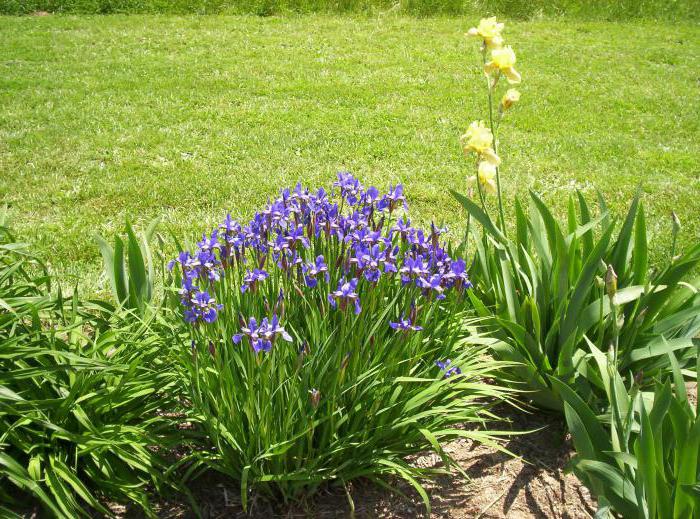
Varieties and varieties of bulbous irises: descriptions and nuances of care and cultivation
As a rule, irises are self-rooted plants, they are also called rhizomatous, but there are also bulbous flowers. Despite the fact that outwardly they are very similar and it is almost impossible to distinguish them, planting and caring for them are somewhat different.
Bulbous irises include 3 distinct genera, each with its own characteristics: xyphium, iridodictium, and juno.
Landscaping for the busy, beautiful garden and vegetable garden without hassle
A training course for those who want to make their summer cottage beautiful and prefer to wisely spend time, effort and money.
Special offer! Discount 83%! Self-isolate profitably!
₽ 5000 ₽ 790
Xiphium
These bulbous irises got this name due to the shape of their leaves, reminiscent of swords (from the Greek "xiphium" - "sword"), respectively, they are narrow and elongated.
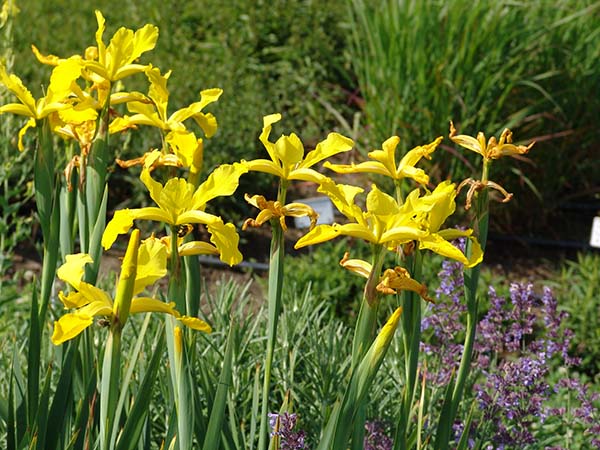
The shape of flowers in xyphyums is the simplest of all bulbous irises, but rather large - up to 10 centimeters in diameter. The height of the flowers themselves is from 30 to 80 centimeters.

The inflorescences of these irises have purple, blue, blue, yellow or white flowers. You can often find a two-tone color. It all depends on what specific species and variety you purchase.
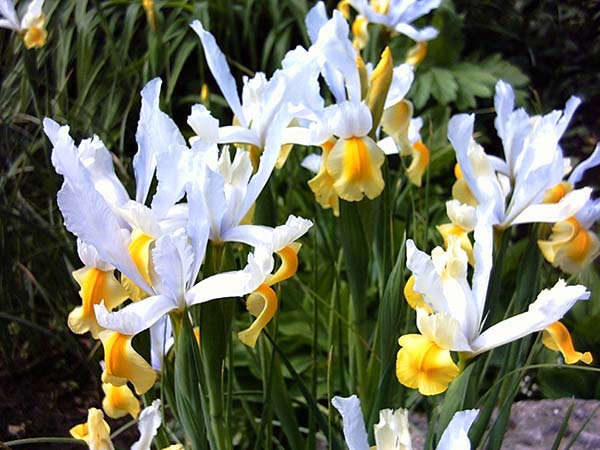
Iridodictium (Iridodictyum) or reticulated (reticulata)
Such a complex name ("Iridodictium") got these bulbous flowers because of the bright (variegated) color of their inflorescences (from the Greek "iris" - "rainbow") and the structure of the upper layer of the bulbs, which, as it were, in a mesh (from the Greek. "Diction" - "grid"), so they are sometimes called mesh.

The place of active growth is the mountainous area of Central Asia and the Western Urals, as well as the Caucasus and the Balkans. Actually, therefore, they are the most adaptable to difficult conditions, for example, the same middle zone (Moscow region), and theoretically they can be grown in one place for 4-5 years without digging for the summer.
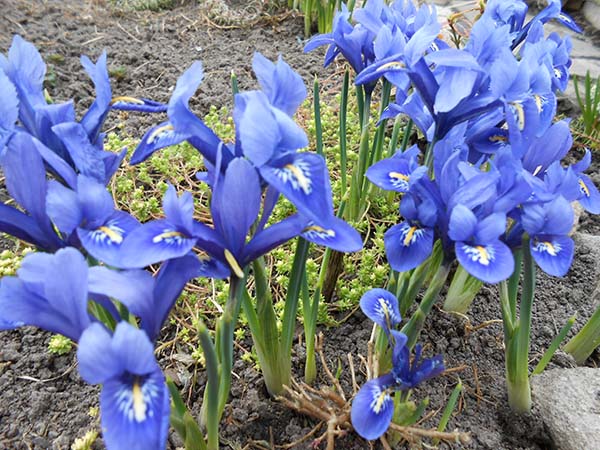
Iridodictiums are quite miniature in size. In height, they can reach no more than 15 cm, the diameter of the flowers is about 5-7 cm. The leaves of these bulbous flowers are narrow and tough, appear simultaneously with the buds. A distinctive feature of iridodictiums is their amazing, one might even say, exotic flowers, which not only have a very unusual color, but they still smell pleasantly, possessing a very rich aroma.
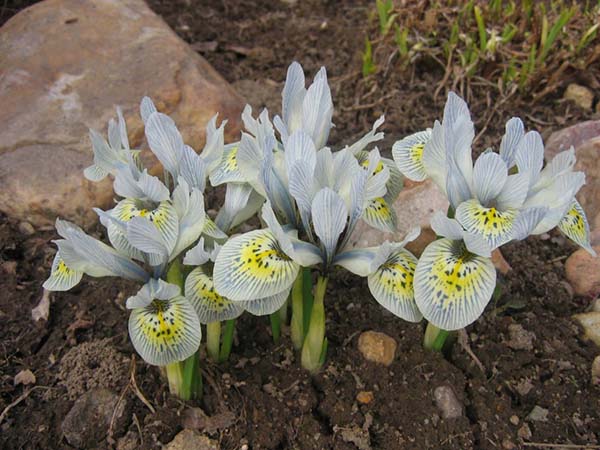
As a rule, the flowering period of iridodictiums falls on March-April, the period is about 2 weeks.
Juno
It is not hard to guess where these bulbous irises got their name from. Yes, that's right, in honor of the name of the Roman goddess Juno, who was considered the main patroness of women.
They are very widespread in the mountains of the Caucasus, in Asia Minor and Central Asia, in South Africa, as well as in the Mediterranean. Therefore, along with iridodictiums, junons are considered quite viable and can grow safely up to 4-5 years in the same place without digging and transplanting.
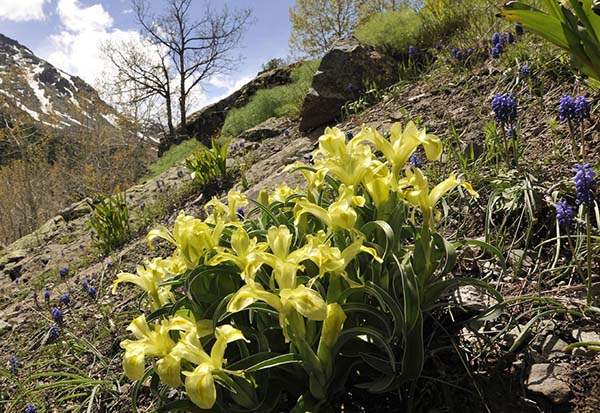
Depending on the species (they are the most widely represented - 40 species, iridodictium - 11, and xyphium - only 6 species), the height of plants can vary within 10-50 centimeters.
The structure of the juno is the most unusual among all bulbous irises: the leaves grow in several rows on the trunk, and flowers appear from the axils of these leaves, as well as at the top of the stem.

Their inflorescences, as a rule, can be white, yellow, purple and lilac in color. And some species have a very pleasant smell.
In most cases, junons bloom a little later than reticulated irises, that is, in April-May, but longer, somewhere in 2-3 weeks.
